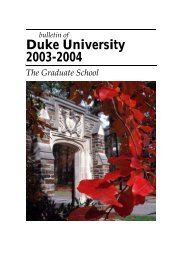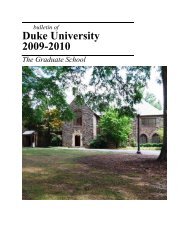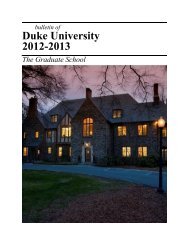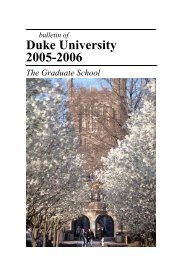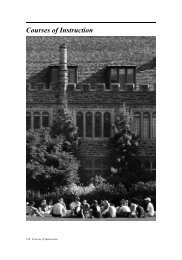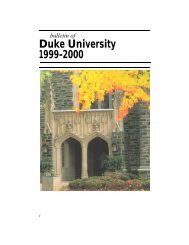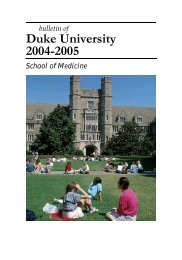Duke University 2008-2009 - Office of the Registrar - Duke University
Duke University 2008-2009 - Office of the Registrar - Duke University
Duke University 2008-2009 - Office of the Registrar - Duke University
You also want an ePaper? Increase the reach of your titles
YUMPU automatically turns print PDFs into web optimized ePapers that Google loves.
methods. Prerequisite: Electrical and Computer Engineering 271 or consent <strong>of</strong> instructor.<br />
Instructor: Carin or Liu. 3 units.<br />
278. Inverse Problems in Electromagnetics and Acoustics. Systematic discussion <strong>of</strong><br />
practical inverse problems in electromagnetics and acoustics. Hands-on experience with<br />
numerical solution <strong>of</strong> inverse problems, both linear and nonlinear in nature. Comprehensive<br />
study includes: discrete linear and nonlinear inverse methods, origin and solution <strong>of</strong><br />
nonuniqueness, tomography, wave-equation based linear inverse methods, and nonlinear<br />
inverse scattering methods. Assignments are project oriented using MATLAB.<br />
Prerequisites: Graduate level acoustics or electromagnetics (Electrical and Computer<br />
Engineering 271), or consent <strong>of</strong> instructor. Instructor: Liu. 3 units.<br />
279. Waves in Matter. Analysis <strong>of</strong> wave phenomena that occur in materials based on<br />
fundamental formulations for electromagnetic and elastic waves. Examples from <strong>the</strong>se and<br />
o<strong>the</strong>r classes <strong>of</strong> waves are used to demonstrate general wave phenomena such as dispersion,<br />
anisotropy, and causality; phase, group, and energy propagation velocities and directions;<br />
propagation and excitation <strong>of</strong> surface waves; propagation in inhomogeneous media; and<br />
nonlinearity and instability. Applications that exploit <strong>the</strong>se wave phenomena in general<br />
sensing applications are explored. Prerequisites: Electrical and Computer Engineering 53L.<br />
Instructor: Cummer. 3 units.<br />
281. Random Signals and Noise. Introduction to ma<strong>the</strong>matical methods <strong>of</strong> describing and<br />
analyzing random signals and noise. Review <strong>of</strong> basic probability <strong>the</strong>ory; joint, conditional,<br />
and marginal distributions; random processes. Time and ensemble averages, correlation,<br />
and power spectra. Optimum linear smoothing and predicting filters. Introduction to<br />
optimum signal detection, parameter estimation, and statistical signal processing.<br />
Prerequisite: Ma<strong>the</strong>matics 135 or Statistics 113. Instructor: Collins or Nolte. 3 units.<br />
282. Digital Signal Processing. Introduction to <strong>the</strong> fundamentals <strong>of</strong> processing signals by<br />
digital techniques with applications to practical problems. Discrete time signals and<br />
systems, elements <strong>of</strong> <strong>the</strong> Z-transform, discrete Fourier transforms, digital filter design<br />
techniques, fast Fourier transforms, and discrete random signals. Prerequisite: Electrical and<br />
Computer Engineering 281 or equivalent with consent <strong>of</strong> <strong>the</strong> instructor. Instructor: Nolte,<br />
Tantum, or Willett. 3 units.<br />
283. Digital Communication Systems. Digital modulation techniques. Coding <strong>the</strong>ory.<br />
Transmission over bandwidth constrained channels. Signal fading and multipath effects.<br />
Spread spectrum. Optical transmission techniques. Prerequisite: Electrical and Computer<br />
Engineering 281 or consent <strong>of</strong> instructor. Instructor: Staff. 3 units.<br />
284. Acoustics and Hearing (GE, IM). 3 units. C-L: see Biomedical Engineering 235<br />
285. Signal Detection and Extraction Theory. Introduction to signal detection and<br />
information extraction <strong>the</strong>ory from a statistical decision <strong>the</strong>ory viewpoint. Subject areas<br />
covered within <strong>the</strong> context <strong>of</strong> a digital environment are decision <strong>the</strong>ory, detection and<br />
estimation <strong>of</strong> known and random signals in noise, estimation <strong>of</strong> parameters and adaptive<br />
recursive digital filtering, and decision processes with finite memory. Applications to<br />
problems in communication <strong>the</strong>ory. Prerequisite: Electrical and Computer Engineering 281<br />
or consent <strong>of</strong> instructor. Instructor: Nolte. 3 units.<br />
286. Digital Processing <strong>of</strong> Speech Signals. Detailed treatment <strong>of</strong> <strong>the</strong> <strong>the</strong>ory and application<br />
<strong>of</strong> digital speech processing. Modeling <strong>of</strong> <strong>the</strong> speech production system and speech signals;<br />
speech processing methods; digital techniques applied in speech transmission, speech<br />
syn<strong>the</strong>sis, speech recognition, and speaker verification. Acoustic-phonetics, digital speech<br />
modeling techniques, LPC analysis methods, speech coding techniques. Application case<br />
studies: syn<strong>the</strong>sis, vocoders, DTW (dynamic time warping)/HMM (hidden Markov<br />
modeling) recognition methods, speaker verification/identification. Prerequisite: Electrical<br />
and Computer Engineering 182 or equivalent or consent <strong>of</strong> instructor. Instructor: Staff. 3<br />
units.<br />
Courses <strong>of</strong> Instruction 152



